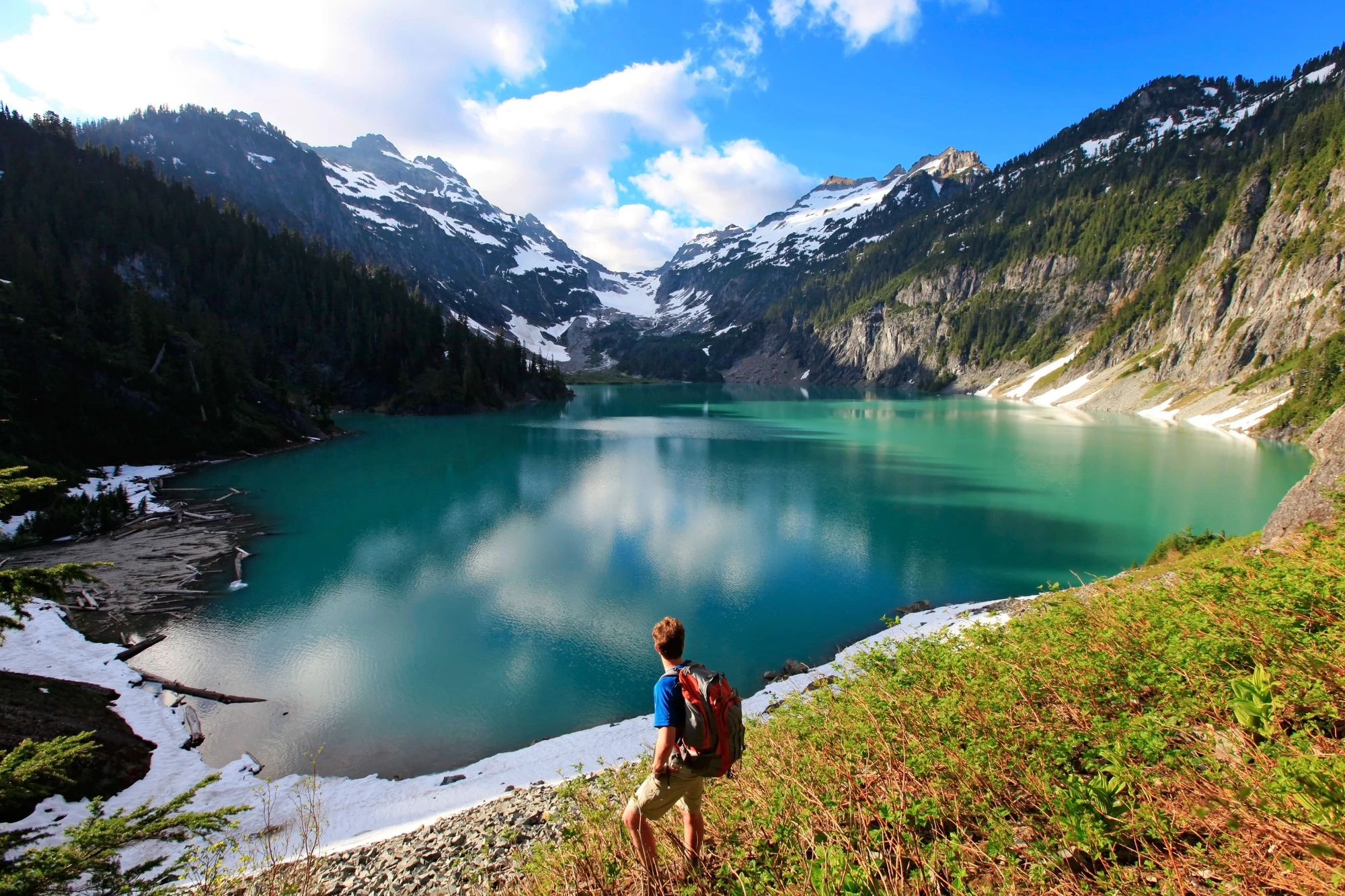Blanca Lake: The Turquoise Reward at the End of a Steep Cascade Climb
Earn the color — a steep, scenic climb to one of Washington’s most photogenic alpine lakes
Photo by Artazum
Shutterstock (ID: 75001846)
A breath of cold air bites at your cheeks as the forest opens and the lake arrives like an impossible gem. Blanca Lake sits cupped beneath knife-edged ridgelines in the Henry M. Jackson Wilderness—its color a startling, highlighter-green blue that shifts with the sun and the motion of wind across the surface. For much of the climb you move through a cathedral of western hemlock and Douglas fir, but toward the top the trees thin, talus fields take over, and the trail pivots to expose one breathtaking, wind-scoured view after another. By the time you step onto the moraine above the shore, you understand why hikers call Blanca a reward earned: 8 miles round-trip and roughly 2,700 feet of elevation gain condense into a visual punch that makes the sweat worthwhile.
Trail Wisdom
Start early to beat crowds
Parking is limited and the shoreline fills on summer weekends—arrive before 8 a.m. for the best spaces and light.
Bring traction in spring
Snow can persist into June; microspikes or crampons and trekking poles improve safety on icy sections.
Protect the shoreline
Use established campsites and avoid trampling vegetation on the moraine—Blanca’s shore is ecologically fragile.
Pack water and filter
Water is scarce near the lake—carry at least 2 liters and a lightweight filter if you plan to refill.
Local Knowledge
Hidden Gems
- •Small viewpoints on the upper switchbacks that offer uninterrupted views of the lake before the final descent
- •A moraine camping area set back from the shoreline with better wind shelter and sunrise views
Wildlife
black bear, marmot
Conservation Note
High use has caused localized erosion and vegetation loss; stick to established trails and campsites to limit impact and help preserve the lake’s clarity.
The surrounding region has mining and logging history from the late 19th and early 20th centuries; the Henry M. Jackson Wilderness was later designated to protect these high-elevation waters.
Seasonal Guide
spring
Best for: wildflower displays, fewer crowds
Challenges: lingering snow, muddy lower trail
Expect snowfields on the higher reaches and muddy trails lower down; traction and patience are important.
summer
Best for: clear views, photography, day-hiking
Challenges: crowds on weekends, hot exposed sections
Highs bring stable weather and the lake at peak color—start early to avoid crowds and afternoon storms.
fall
Best for: crisp air, fewer visitors, clear light
Challenges: early snow possibility, shorter daylight
Cooler temperatures mean excellent visibility; watch for early-season snow at higher elevation.
winter
Best for: snowshoeing for experienced backcountry users, quiet solitude
Challenges: deep snow, avalanche risk, limited access on forest roads
Winter access requires snow travel skills and avalanche awareness; many approach roads are unplowed.
Photographer's Notes
What to Bring
Hiking boots with good tractionEssential
Stability and ankle support help on steep, rooty switchbacks and loose talus near the lake.
Microspikes or crampons
Useful for icy or snowy sections in spring and winter to maintain traction.
Water filter and 2+ litersEssential
Water sources are limited above the tree line; filtering allows safe refills.
Windproof layer and sun protectionEssential
Exposed ridgelines can be windy and sun intense—bring a lightweight shell and sunscreen.
Common Questions
How long is the Blanca Lake hike?
The standard route is about 8 miles round-trip with approximately 2,700 feet of elevation gain; most parties take 4–6 hours for the day hike.
Is Blanca Lake safe for swimming?
Technically yes, but the water is glacially fed and very cold—swimming is brief and refreshing rather than leisurely.
Do I need a permit to hike Blanca Lake?
No day-use permit is typically required, but overnight camping may require adherence to Forest Service camp rules; check local regulations before you go.
When is the best time to photograph the lake?
Morning and early evening provide softer light and fewer people; mid-summer mornings often give calm water for mirror-like reflections.
Can dogs go on the trail?
Dogs are allowed but the steep, exposed sections and loose rock can be hard on paws—bring traction for dogs and consider fitness and safety.
Is the trailhead accessible with a normal passenger car?
Many hikers use standard cars, but forest roads can be rough in places—high clearance is helpful, especially after rain.
What to Pack
Sturdy boots for traction, 2+ liters of water and filter for refills, a windproof layer for exposed ridge weather, microspikes in spring for icy patches
Did You Know
Blanca Lake’s vivid color comes from glacial 'rock flour'—finely ground sediment suspended in the water that scatters light and creates the lake’s signature hue.
Quick Travel Tips
Arrive early to secure parking; check road conditions for the forest service access road; pack out everything—no shoreline fires; watch the afternoon forecast for thunderstorms
Local Flavor
Darrington’s small-town culture is built on logging and outdoor life—grab a coffee or a post-hike sandwich there and chat with locals for up-to-date trail conditions and stories about the Cascades.
Logistics Snapshot
Trail: ~8 miles RT | Elevation: ~2,700 ft gain | Time: 4–6 hrs | Nearest town: Darrington | Parking: limited; arrive early | Permits: none for day use—check rules for overnight stays
Sustainability Note
Avoid washing or camping too close to the lake to prevent sediment and soap contamination; use established campsites and pack out all waste to protect the fragile alpine environment.

